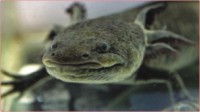Environment

AP, an Axolotl salamander, or Ambystoma mexicanum, swims to the surface for air in a tank at the Chapultepec …
Beneath the tourist gondolas in the remains of a great Aztec lake lives a creature that resembles a monster and a Muppet with its slimy tail, plumage-like gills and mouth that curls into an odd smile.
 The axolotl, also known as the "water monster" and the "Mexican walking fish," was a key part of Aztec legend and diet. Against all odds, it survived until now amid Mexico City's urban sprawl in the polluted canals of Lake Xochimilco, now a Venice-style destination for revelers poled along by Mexican gondoliers, or trajineros, in brightly painted party boats. The axolotl, also known as the "water monster" and the "Mexican walking fish," was a key part of Aztec legend and diet. Against all odds, it survived until now amid Mexico City's urban sprawl in the polluted canals of Lake Xochimilco, now a Venice-style destination for revelers poled along by Mexican gondoliers, or trajineros, in brightly painted party boats.
But scientists are racing to save the foot-long salamander from extinction, a victim of the draining of its lake habitat and deteriorating water quality. In what may be the final blow, nonnative fish introduced into the canals are eating its lunch and its babies.
The long-standing International Union for Conservation of Nature includes the axolotl on its annual Red List of threatened species, while researchers say it could disappear in just five years. Some are pushing for a series of axolotl sanctuaries in canals cleared of invasive species, while others are considering repopulating Xochimilco with axolotls bred in captivity.
"If the axolotl disappears, it would not only be a great loss to biodiversity but to Mexican culture, and would reflect the degeneration of a once-great lake system," says Luis Zambrano, a biologist at the Autonomous University of Mexico, or UNAM.
The number of axolotls (pronounced ACK-suh-LAH-tuhl) in the wild is not known. But the population has dropped from roughly 1,500 per square mile in 1998 to a mere 25 per square mile this year, according to a survey by Zambrano's scientists using casting nets.
It has been a steep fall from grace for the salamander with a feathery mane of gills and a visage reminiscent of a 1970s Smiley Face that inspired American poet Ogden Nash to pen the witticism: "I've never met an axolotl, But Harvard has one in a bottle."
 Millions once lived in the giant lakes of Xochimilco and Chalco on which Mexico City was built. Using four stubby legs to drag themselves along lake bottoms or their thick tails to swim like mini-alligators, they hunted plentiful aquatic insects, small fish and crustaceans. Legend has it that Xolotl the dog-headed Aztec god of death, lightning and monstrosities feared he was about to be banished or killed by other gods and changed into an axolotl to flee into Lake Xochimilco. The axolotl's decline began when Spanish conquerors started draining the lakes, which were further emptied over time to slake the thirst of one of the world's largest and fastest-growing cities. Millions once lived in the giant lakes of Xochimilco and Chalco on which Mexico City was built. Using four stubby legs to drag themselves along lake bottoms or their thick tails to swim like mini-alligators, they hunted plentiful aquatic insects, small fish and crustaceans. Legend has it that Xolotl the dog-headed Aztec god of death, lightning and monstrosities feared he was about to be banished or killed by other gods and changed into an axolotl to flee into Lake Xochimilco. The axolotl's decline began when Spanish conquerors started draining the lakes, which were further emptied over time to slake the thirst of one of the world's largest and fastest-growing cities.
In the 1970s, Lake Chalco was completely drained to prevent flooding. In the 1980s, Mexico City began pumping its wastewater into the few canals and lagoons that remained of Xochimilco. About 20 years ago, African tilapia were introduced into Xochimilco in a misguided effort to create fisheries. They joined with Asian carp to dominate the ecosystem and eat the axolotl's eggs and compete with it for food. The axolotl is also threatened by agrochemical runoff from nearby farms and treated wastewater from a Mexico City sewage plant, researchers say.
Local fisherman Roberto Altamira, 32, recalls when he was a boy, and the axolotl was still part of the local diet.
"I used to love axolotl tamales," he says, rubbing his stomach and laughing. But he says people no longer eat axolotls, mainly because fishermen almost never find them.
"The last one I caught was about six months ago," says Altamira, a wiry gondolier with rope-like muscles from years of poling through Xochimilco's narrow waterways. Meanwhile, the axolotl population is burgeoning in laboratories, where scientists study its amazing traits, including the ability to completely re-grow lost limbs. Axolotls have played key roles in research on regeneration, embryology, fertilization and evolution. The salamander has the rare trait of retaining its larval features throughout its adult life, a phenomenon called neoteny. It lives all its life in the water but can breathe both under water with gills or by taking gulps of air from the surface.
On a 9-foot-wide canal covered by a green carpet of "lentejilla" an aquatic plant that resembles green lentils Zambrano's researchers test water quality and search for axolotls. The air smells of sulfur and sewage.
A team member suddenly points to the trademark water ripple of an axolotl, and the crew hurls its net. But they only come up with two tilapia in a sopping-wet mass of lentejilla. So far, scientists disagree on how to save the creature. But a pilot sanctuary is expected to open in the next three to six months in the waters around Island of the Dolls, so-called because the owner hangs dolls he finds in the canals to ward off evil spirits.
Zambrano proposes up to 15 axolotl sanctuaries in Xochimilco's canals, where scientists would insert some kind of barrier and clear the area of nonnative species. Without carp, the water would clear, and plants the axolotl needs to breed could flourish again, said Bob Johnson, the curator of amphibians and reptiles at the Toronto Zoo.
| 